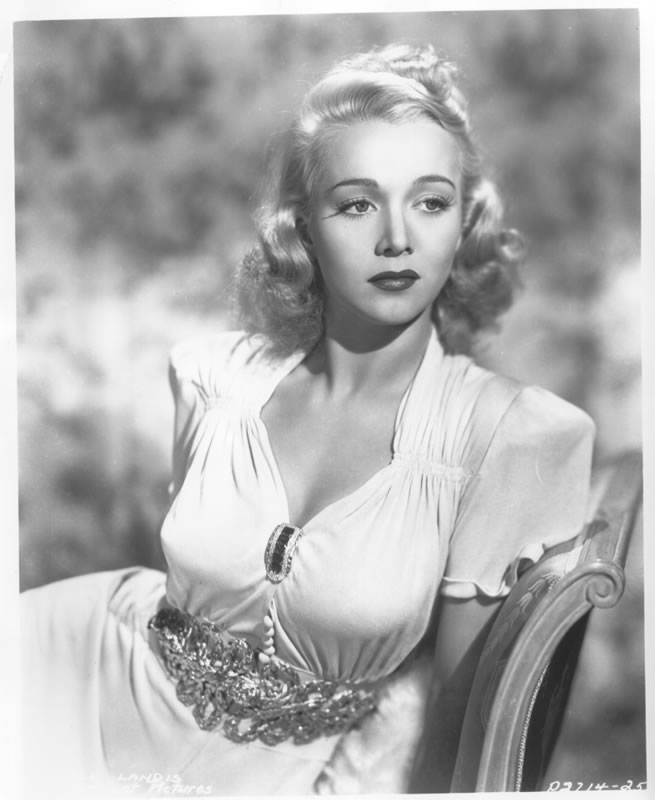Few readers will be able to identify the subject of this photograph: Carole Landis, who committed suicide on July 5, 1948 at the age of 29. Hers was a name I had only heard; an actress who played in no major films and who died before I was seven years old. The other night, I watched the quasi-film noir I Wake up Screaming, with Landis as a murder victim whose killer is hunted down by Victor Mature and Betty Grable, who plays her sister. Carole Landis was so unfamiliar to me that on her first appearance in the picture I was surprised to find Betty Grable so beautiful; it took me a moment to realize that Betty was playing the other role.
In a brief exploration of the Internet, the source of all wisdom, I chanced upon this breathtaking portrait. It is, quite simply, the most perfect representation of a woman’s beauty–of beauty itself–that I have ever seen. Since finding it, I have perused for purpose of comparison hundreds of publicity shots, from the 1930s to the present day. Most are wholly forgettable, some are pretty, many are supposed to be sexy but succeed only in being vulgar, a few are truly sexy, and a very few are portraits that give some insight into their subject. I found none to compare with this one. Seek for yourself, dear reader.
Especially today, but in fact from the beginning, as the Bible and Georges Bataille tell us, there has been a shamefulness attached to a man’s desire for a woman (women’s desires for men, in contrast, lacking this element of shame, are consequently seen, and feared by men, as shameless). To desire is to threaten the self’s dissolution in the imaginary but always potentially real sparagmos suffered by the peripheral worshiper who dares move toward the center. The “homosocial” sphere until recently so powerful allowed the transcendence of shame by relocating desire in the context of a friendly rivalry for an object considered fundamentally unworthy. The accession of women to more or less equal social and professional roles (a consequence of the postwar victimary critique) has relegated this kind of camaraderie to the lower reaches of the moral order, with the result of removing shame’s protection.
The role of the bosom in feminine attractiveness is particularly vulnerable to this intensification of shame. Biologically speaking, women’s secondary sexual characteristics have clearly been the object of a very intense selection; just take a look at a female chimpanzee. But desire is shameful; the endless talk about women’s breasts reflects a great uneasiness. The everyday world respects Jesse Ventura’s desire to be reincarnated as a 38DD bra, but the only women in public life with such attributes are figures of fun, the most egregious of whom, Anna-Nicole Smith, shares with Ozzy Osbourne the newly invented role of TVcam scapegoat.
To admire the photograph above is to accept without shame the bosom’s importance as an element of female beauty. The myriad decolletés that dominate publicity collections rarely succeed even in being sexually attractive, no doubt because, were they to do so, they would risk stepping over the line that separates “innocent” erotic art, quaintly known as cheesecake, from pornography. Cheesecake is a secondary representation of sexual beauty, like the “myths” described by Roland Barthes: it represents the desirable without directly arousing desire, which appears only through its mimetic detour. In contrast, pornography alludes directly to sexual activity; if enough bandwidth is available, it displays such activity in detail. Its effect, which one can turn away from but not avoid, is mimetically to induce the spectator to equivalent activity. Pornography avoids the paradox of esthetic experience, the reliance on the representation’s standing outside the world of the imagination it generates and that depends upon it, by opening a parallel path of fulfillment through the sexual excitation it inspires, relying on the fact, whose adaptiveness needs no explanation, that sexual desire is capable of generating its own satisfaction.
No doubt affirming that one finds a woman’s bosom beautiful, as opposed to simply desirable, seems hypocritical, more than ever in our day of Hooters restaurants. And that is precisely what explains the remarkable fact that our feminine iconography, obsessed with the bosom, so rarely presents it without disfiguring insistence as a harmonious element of a beautiful whole. Compare our Landis photo with that of Jane Russell (which sells for 500 times its price!), or even that of the iconic Marilyn Monroe.
 |
 |
Our photograph, neither cheesecake nor pornography, transfigures Carole Landis into a work of art that both arouses desire and transcends it. What sets this photograph apart from all others is, first of all, the dignity of her face in its unostentatious revelation of the tension between pride and sadness. This tension reflects its subject’s historical location on the cusp between the opaque sexuality, innocent or “fatal,” of the prewar, patriarchal era and the self-assertive seductiveness of the feminist generation, which tells the spectator, “look at my body, but know that I know I am more than just a body.” Too late for the former, too early for the latter, Landis was denied both easy solutions, which explains at least in part why she and many other beautiful actresses of her generation met with sad ends. Something of the same expression is visible in another portrait that shows Landis drowning in white fluff, a 1940s Ophelia.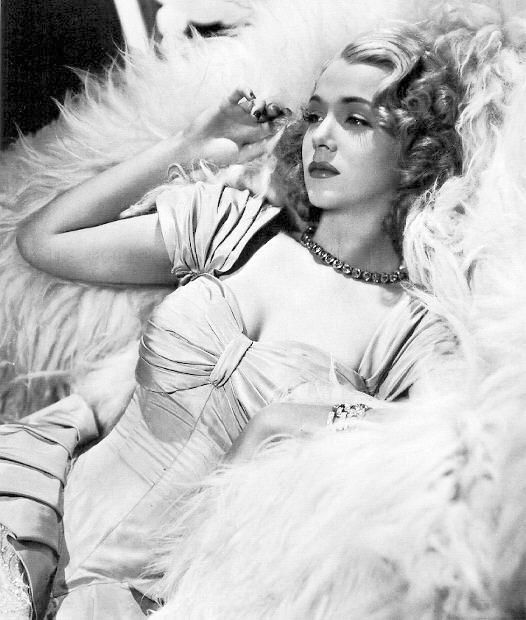
Pride and sadness, pride in her extraordinary beauty, sadness in knowing that to live on this beauty is to degrade it, not so much by displaying it on screen as by commodifying it on Hollywood’s casting couches. This tension, ultimately destructive of its subject’s life, is held in suspension for the split second’s duration of this portrait, which acknowledges beauty as an objective fact, a source of neither triumph nor abjection. Landis’ expression, devoid of resentment, seeks neither domination nor revenge, only recognition of what is.
* * *
The photograph bears the mark of its place and time. Black and white was still the common idiom, of motion pictures as well as still shots. Landis’ clothing and accessories, make-up, and hairdo bespeak the careful grooming and just slightly vulgar elegance of studio-era Hollywood, as do the exaggerated 40s shoulder line and the out-of-focus studio backdrop, and even her name, pieced together from Carole Lombard and baseball commissioner Kenesaw Mountain Landis. The beauty of this or any photograph, which at its best outshines, as this example shows, all other modes of plastic representation, is guaranteed by the reality of its object as it exists at the moment of its formal transfiguration.
The typical publicity shot showing an actress looking smilingly or suggestively at the camera is hardly pornography, yet it is not art either. It alludes not to sexual activity but to the socially admissible accessory activities of courtship and marriage that make up, generally speaking, the tragic or comic subject matter of the films the actress plays in. Landis herself posed for plenty of such photographs, in a great variety of modes; it is sometimes difficult to see them all as portraits of the same person. Today they have the charm of period pieces, figures of female beauty of an unpretentious dignity rare in the genre. But this charm is incommensurable with the power of our portrait, which finds in Landis herself and in the historical moment she embodies the material of esthetic revelation.
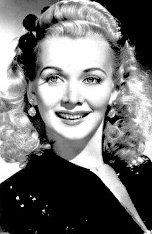 |
 |
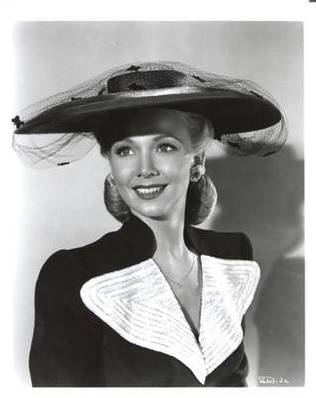 |
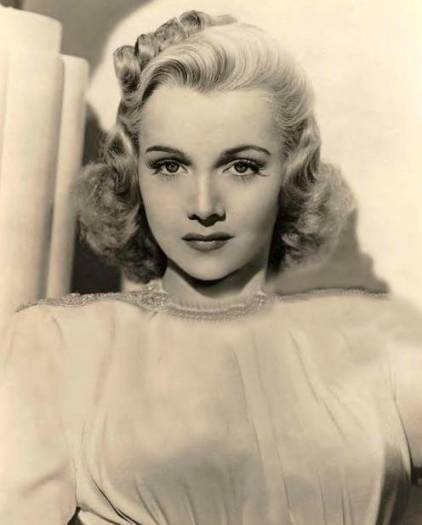 |
 |
We may contrast our portrait with the rightmost photograph above, which shows Landis in the same dress, the same chair, almost certainly at the same time. The composition is strongly vertical, emphasizing the line of the arm and, accessorily, the curve of the bust. Here she looks directly at the camera, with a hint of a smile that covers like a mask the tension between inwardness and ingratiation, pride and humility. A certain haughtiness in this smile, contrasting with the more natural expressions of the other shots, reflects the fragility of this equilibrium.
In our portrait, this problematic self-consciousness is not only displayed in Landis’ facial expression but echoed in the tension of her body, the head turned to the right, the chest thrust just slightly forward and to the left, the curved line down the left side of her face and her neck to her bosom countered by the strong horizontal of the belt that is in turn contained by the upward curve of the chair. The face is turned away, the body toward the spectator; the spirit does not deny the flesh, but discreetly asserts its independence of it, as a separate element in a dynamic harmony. Landis’ face hesitates between a brachycephalic and a dolichocephalic esthetic, which alternate in the other pictures: the lower part of her face is long, the upper part is broad; she is both avid and cerebral. Our portrait displays this tension and its resolution, whereas the elongated picture, with the downward tilt of the head, merely makes it indeterminate.
* * *
Let there be no mistake; I am not claiming that Carole Landis was the most beautiful woman in history, or even the most beautiful Hollywood actress of the 1940s. Comparing beauty in this way is a category mistake, degrading an interactive relation to a linear measurement. Yet such a portrait cannot but reveal its subject. Carole Landis, whose short life ended so sadly, was a woman of great talent and generosity, whose tireless USO work during the war made her beloved of GIs and Allied soldiers. We should remember this as we accept from her the lasting gift of this perfect portrait that is, for me at least, the very incarnation of the beautiful.
Even when he was not thinking of the little phrase, it existed latent in his mind on the same footing as certain other notions without material equivalent, such as our notions of light, of sound, of perspective, of physical pleasure, the rich possessions wherewith our inner temple is diversified and adorned. Perhaps we shall lose them, perhaps they will be obliterated, if we return to nothingness. But so long as we are alive, we can no more bring ourselves to a state in which we shall not have known them than we can with regard to any material object, than we can, for example, doubt the luminosity of a lamp that has just been lit, in view of the changed aspect of everything in the room, from which even the memory of the darkness has vanished. . . . Perhaps it is not-being that is the true state, and all our dream of life is inexistent; but, if so, we feel that these phrases of music, these conceptions which exist in relation to our dream, must be nothing either. We shall perish, but we have as hostages these divine captives who will follow and share our fate. And death in their company is somehow less bitter, less inglorious, perhaps even less probable. (Marcel Proust – Swann in Love)
Postscript: Carole Landis in Film and History
Watching Carole Landis on screen is a very different experience from gazing at her photographs. In posed shots, her face is a harmonious whole, whether that of our portrait’s dynamic equilibrium or the simpler harmonies of hundreds of others. On screen, however, as, presumably, in real life, her face exhibits a remarkable complexity. I alluded above to the tension between the long lower face and the broad forehead; in a motion picture, one observes in addition that the planes of her forehead and the lower part of her profile, marked by a pronounced overbite, are unusually independent of each other. Watching her on screen generates a vague anxiety lest her radiant but precarious beauty disintegrate as soon as it is no longer held together by the vitality of her smile–an anxiety that risks distracting our attention from her fictional role. The unique vulnerability of Landis’ face contributes to the resolved tension of our beautiful portrait a supplemental energy of which I had been only vaguely aware.
This vulnerability, in turn, gives all the more significance to the serene gracefulness of Landis’ body. If her face sometimes seems to be barely held together, her body is always harmonious and at ease. The anxiety provoked by the first is constantly allayed by the sight of the latter. This again is brought out in our portrait; although it stops just below the waist, the leftward turn of the hips suggests the long, elegant legs we see in the photograph below. Landis, who excelled in athletics as a girl, is tall without being “statuesque”; her lovely figure never panders to its admirer.
If beauty depends on the interdependence of a representation and its imaginary object, then the greatest beauty is the most fragile because the most clearly impossible to conceive without its representational support. In Landis’ case the personal fragility that we sense on screen embodies the moment of transition between two eras defined by the war that defined the limits of human violence. What I described in Landis’ face as the tension between pride and sadness is of the very essence of the esthetic object, whose subject both affirms its presence and hides it behind its representation. Our portrait’s uniqueness reflects the emergence of the postwar sensibility that would no longer allow the mass media to “innocently” offer up to their spectators images of desirable otherness. Our portrait is a lasting memento of the moment when not just glamour photography but representation as such lost its claim to secular innocence.
* * *
Carole Landis’ extraordinary efforts for USO during WWII, which permanently damaged her health, were the product of the generosity and graciousness witnessed by all who knew her. This opportunity to make a gift to others of her talent and beauty was without a doubt the high point of Landis’ life. Such innocent generosity could not be maintained after the war. One Hollywood cliché is that Landis was “Marilyn before Marilyn,” but the effect of her suicide was rather to avoid becoming “Marilyn,” the postwar tease whose self-caricaturing sensuality was cheesecake of the mind. Landis’ dignity would have been more consonant with the honestly assertive sexuality of today’s post-feminist age.
At the end of Four Jills in a Jeep, a nondescript wartime film taken from Landis’ own book about her USO experiences, in a makeshift theater in an unnamed North African city, Carole finally gets to sing in her throaty voice “I’m Crazy.” But just as she starts to sing, the lights go out and her song is interrupted. She restarts the song under the ghostly illumination cast by the flashlights of the attending soldiers, as if in an eerie premonition of her death only four years later.
Sad as her suicide was, it is a blessing not to have seen Landis as a “TV personality” or a foil to Doris Day. She belongs to another time, one in which she could offer herself to others as a gift that, in turn, guaranteed her beauty’s exquisite and fragile harmony. Carole Landis’ gravestone reads: “To our beloved Carole whose graciousness and kindness touched us all–who will always be with us in the beauties of this earth until we meet again.”



